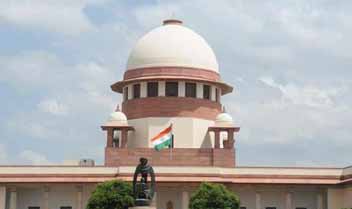INVC NEWS New Delhi – In a bold judicial step reflecting India’s evolving stance on digital content accountability, the Supreme Court of India has issued notices to the Central Government, leading OTT platforms such as Netflix, Amazon Prime Video, ALT Balaji, Ullu Digital, MUBI, and social media giants including Meta, Google, X (formerly Twitter), and Apple, demanding a response over the unregulated spread of obscene and explicit material accessible to the public—particularly minors.
A Wake-Up Call from the Bench
Presiding over a set of public interest petitions seeking regulation of vulgar and obscene content on OTT and social media platforms, Justice B.R. Gavai and Justice A.G. Masih stated that the matter was “deeply concerning” and warrants immediate attention. The bench made it clear that these platforms can no longer operate in a regulatory vacuum, while inappropriate and explicit content continues to circulate freely without age verification barriers or parental control mechanisms.
Justice Gavai, who is also poised to become the next Chief Justice of India, remarked, “We’ve seen children being handed phones to keep them busy—but what are they consuming?” The concern is that such content, which was previously limited to age-restricted cinema, is now easily accessible on smartphones, tablets, and smart TVs.
Solicitor General Raises Alarm Over Uncensored Shows
Solicitor General Tushar Mehta, representing the Union of India, underscored the core issue by highlighting how explicit language and themes are being normalized in popular shows. “Some programs contain language that isn’t suitable for family viewing. Two people can’t even sit and watch them together,” Mehta stated, emphasizing that mere age disclaimers—“18+ only”—do not absolve content providers of their responsibility to shield impressionable minds.
The Supreme Court bench echoed this sentiment, observing that disclaimers are insufficient in an environment where children and teenagers have uninterrupted access to smartphones. The need for enforceable content filters, parental controls, and accountability mechanisms has never been more urgent.
Government Regulation in Question
Responding to the court’s queries, the Union Government acknowledged that some regulatory mechanisms are already in place under the Information Technology (Intermediary Guidelines and Digital Media Ethics Code) Rules, 2021. However, officials conceded that a re-evaluation is underway, as the current guidelines may fall short in tackling the surge in sexualized, violent, and profane content flooding OTT and social media platforms.
The court emphasized that executive and legislative branches must work together to frame comprehensive digital content regulation policies. The bench stressed that both OTT service providers and tech companies bear collective responsibility for the content hosted and disseminated through their platforms.
Platforms Under Legal Scrutiny
By issuing notices to prominent OTT and social media firms, the apex court has put the entire digital entertainment and communication ecosystem under the scanner. The following companies have been asked to furnish detailed responses:
Netflix
Amazon Prime Video
ALT Balaji
Ullu Digital
MUBI
Meta (Facebook & Instagram)
Google (YouTube & Android)
X (formerly Twitter)
Apple (iOS, App Store)
This move signals that global tech giants operating in India are not immune to judicial oversight and must demonstrate ethical commitment toward content responsibility.
The Moral and Social Implications
The court’s decision arrives at a time when India is grappling with the cultural clash between traditional values and modern digital consumption patterns. Many of the shows hosted on streaming platforms showcase themes like:
Uncensored nudity and simulated sexual acts
Explicit dialogues laced with profanity
Graphic violence and criminal glorification
Subtle normalization of drug abuse and casual relationships
While creative freedom remains a fundamental right, the court raised the pivotal question: Should it come at the cost of the mental health and safety of children?
What’s Next for Content Regulation in India?
The Supreme Court’s move could lead to the establishment of a regulatory framework akin to the Central Board of Film Certification (CBFC) for digital content. Possible future actions may include:
Mandatory age-verification protocols
Parental control enforcement by ISPs and telecom providers
Pre-screening and certification boards for web content
Heavy penalties for non-compliance
Stricter monitoring of algorithm-based content recommendations
If such guidelines are enacted, it will significantly impact the production and distribution strategies of OTT platforms and may even alter the nature of storytelling and web entertainment in India.
Reactions from Industry and Public
The legal development has stirred varied reactions across sectors. While child rights activists and parent groups have welcomed the court’s intervention, filmmakers and digital creators are concerned about the potential stifling of artistic expression.
However, public sentiment strongly leans toward accountability and safer digital spaces. With the explosion of affordable data and smartphones, Indian users—including a massive under-18 demographic—are watching content around the clock, often without supervision.
A Tipping Point for OTT Accountability
India’s Supreme Court has lit a fire under the largely self-regulated OTT industry, signaling the dawn of judicially driven content reform. As these platforms prepare to respond, the coming months will likely shape the future of digital content in the world’s largest democracy.
Will India emerge with a balanced framework that ensures both freedom of expression and child protection? Or will the industry push back in defense of artistic liberty?
One thing is certain—the era of unregulated streaming is over, and a new chapter in digital governance has begun.















